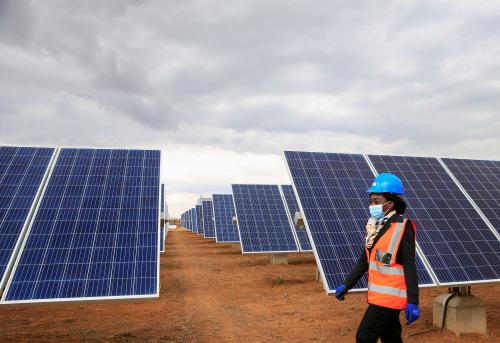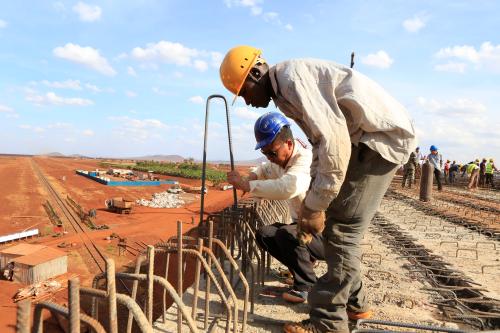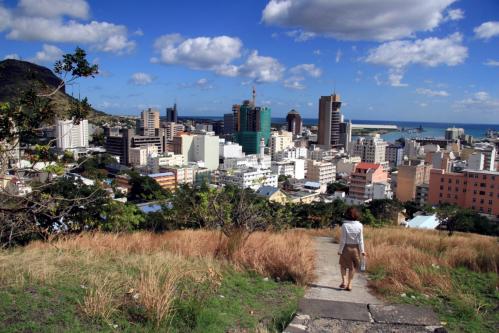One of the pressing obstacles on Africa’s economic growth is its limited infrastructure. In a recent National Bureau of Economic Research working paper, “Spatial Inefficiencies In Africa’s Trade Network,” Harvard doctoral student Tilman Graff studies the spatial inefficiencies of Africa’s transportation industry and its impact on trade. However, the paper does not focus on Africa’s dearth of infrastructure (Africa has approximately 31 kilometers of paved road per 100 square kilometers of land in comparison to 134 kilometers of paved road in other low-income countries). Instead, the author delves into the extent to which the region’s existing infrastructure is in the right place.
Utilizing data from online routing services and satellites, the author generates an “optimal” trade network for each African country via a simulation of trade flows based on an interconnected economic topographic division of the continent. In his analysis, the optimization algorithm works to maximize the efficiencies of trade by reallocating existing road networks. Figure 1 presents a sample of four countries’ “optimized” routes that shuffle existing roads to produce a more fluid trade environment; black lines represent driving as the optimal method of transportation between locations and red lines represent walking as the optimal method of transportation.
Figure 1. Optimal road networks in select African countries
 Source: Tilman Graff, “Spatial Inefficiencies In Africa’s Trade Network,” National Bureau of Economic Research Working Paper Series, 2019.
Source: Tilman Graff, “Spatial Inefficiencies In Africa’s Trade Network,” National Bureau of Economic Research Working Paper Series, 2019.
Note: Black = driving is the optimal mode of transportation; red = walking is the optimal mode of transportation
Per the study, as seen in the above map of Nigeria, the country has relatively efficient road infrastructure, and very few optimal routes require walking. In contrast, Mali, with the Sahara Desert dominating the country’s northern region, exhibits large, concentrated swaths where walking is the optimal method of transportation. Ethiopia’s optimal routes, on the other hand, vary according to subregion. Notably, according to the author, Ethiopia’s transportation infrastructure is predominately structured north-to-south and has few trails that facilitate travel from east to west. In stark contrast to the previous three examples, the relatively small country of Rwanda lacks road density and location nodes, and its geography, based on the author’s analysis, is more conducive to driving as the most efficient mode of transportation.
Overall, says the author, his research suggests that the distribution of Africa’s transportation infrastructure is inefficiently and unequally allocated spatially, as some regions are over overequipped and others underdeveloped.
The author explores several hypotheses to explain why Africa’s roads are inefficiently placed. One hypothesis is that international aid has played a role in the inefficient placement of roads. Although Africa remains the principal target of international aid and projects related to improving transportation infrastructure capture the largest share of international aid commitments to Africa, , this foreign aid funding has yet to be empirically linked with positive economic outcomes, states the author. More specifically, Figure 2 compares the spatial distribution of international aid projects by the World Bank and China, where each circle depicts a project site and the size of the circle represents the projects’ value with a logarithmic price scale.
Figure 2. Spatial distribution of World Bank and Chinese development aid projects
 Source: Tilman Graff, “Spatial Inefficiencies In Africa’s Trade Network,” National Bureau of Economic Research Working Paper Series, 2019.
Source: Tilman Graff, “Spatial Inefficiencies In Africa’s Trade Network,” National Bureau of Economic Research Working Paper Series, 2019.
Note: Circle = project site; size of circle = logarithmic disbursement value of project in U.S. dollars
From this analysis, Graff posits that foreign aid projects have not been successful in alleviating Africa’s imbalanced transportation networks. Although World Bank funding is more spatially diverse than Chinese aid, World Bank funds, more so than Chinese funds, have been directed toward regions with a surplus of road infrastructure development. In fact, he finds between 25 and 33 percent of international aid flows from China and the World Bank share the same geographic destination, which becomes more pronounced for transportation infrastructure aid. The author’s algorithm notably finds a positive relationship between World Bank and Chinese aid and an overabundance of roads.
Another of the author’s hypotheses concerns railway lines: He suggests that regions with railway lines constructed by colonial powers tend to have surplus road infrastructure (Figure 3). According to the hypothesis, colonial rail infrastructure enticed further transportation infrastructure at the same locations due to the “spatial organization of economic activity” and urbanization clustered around those rail networks.
Figure 3. Colonial railroad network
 Source: Tilman Graff, “Spatial Inefficiencies In Africa’s Trade Network,” National Bureau of Economic Research Working Paper Series, 2019.
Source: Tilman Graff, “Spatial Inefficiencies In Africa’s Trade Network,” National Bureau of Economic Research Working Paper Series, 2019.
Note: Red = railroads built by colonial powers from 1890 to 1960; blue = railroad lines that were planned and never built
In this way, the author argues that areas with colonial rail infrastructure tend to have an inefficiently high density of roads relative to other regions. While contemporary economic activity still clusters around these former railway lines, the author argues that their historical purpose to facilitate military maneuverability and support extractive economies no longer provides an efficient trade network today. Notably, some planned railways were never built, and the author finds that it is exclusively the built, rather than the planned, railways that are associated with inefficiency with trade networks.
For more on international investment and aid in Africa, read “American companies and Chinese Belt and Road in Africa” and “Africa’s tourism: A global destination for investment and entrepreneurship.”
For more on African Infrastructure, read “Improving infrastructure in Africa: Creating long-term resilience through investment,” “Figures of the week: Africa’s infrastructure paradox,” and “Figures of the week: Africa’s infrastructure needs are an investment opportunity.”








Commentary
Figures of the week: Africa’s spatial distribution of road infrastructure
March 17, 2021